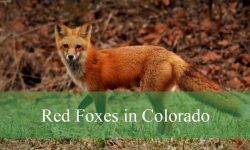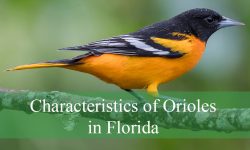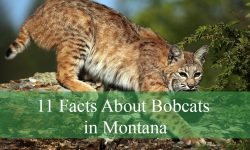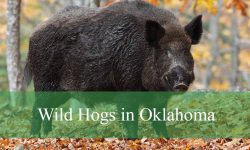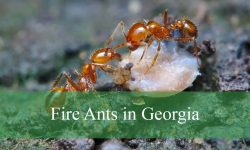Tennessee hosts a diverse range of birds, from familiar backyard species like Northern Cardinals and Carolina Wrens to marsh and woodland inhabitants such as Red-winged Blackbirds and Great Crested Flycatchers. Knowing the key features of each bird—such as plumage, size, calls, and behavior—makes it easier to identify them in the wild. Birdwatching here is rewarding throughout the year, as some species are year-round residents while others migrate seasonally.
This guide highlights 47 common birds in Tennessee, providing detailed descriptions of their appearance, size, behavior, and preferred habitats. It helps birdwatchers and nature enthusiasts recognize and enjoy the variety of birds that populate fields, forests, wetlands, and suburban areas across the state.
Most Common Birds Found in Tennessee
Tufted Titmouse
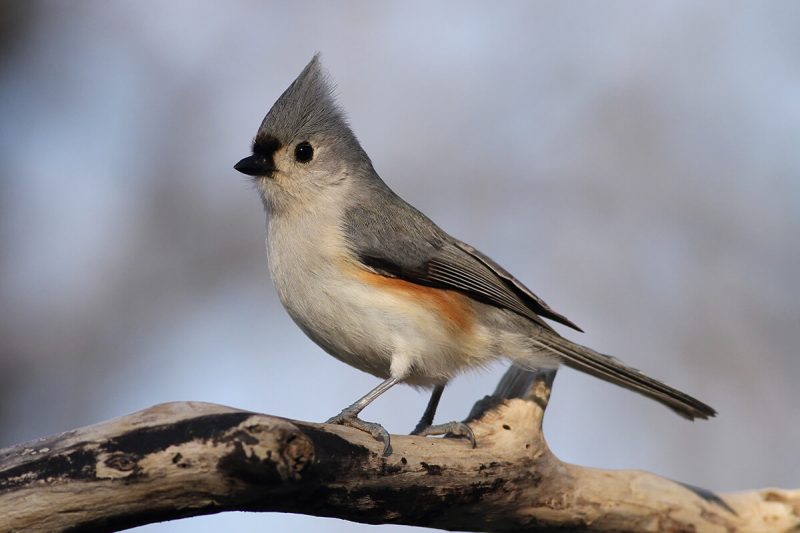
The Tufted Titmouse is a charming little bird with a gray back, white underparts, and a distinctive pointed crest on its head. It has a black forehead and large, dark eyes, giving it an expressive appearance. Its whistled “peter-peter-peter” song is a common sound in Tennessee’s woodlands and backyards.
Measuring about 5.5 to 6.3 inches in length with a wingspan of 7.9 to 10.2 inches, the Tufted Titmouse is a small but agile bird. They often forage in mixed flocks with chickadees, nuthatches, and woodpeckers, moving swiftly through trees in search of insects, seeds, and nuts. They are frequent visitors at feeders, especially when sunflower seeds and suet are available.
Tufted Titmice are year-round residents throughout Tennessee, favoring deciduous forests, wooded suburbs, and gardens. They prefer areas with mature trees, which provide both nesting cavities and food sources. Their curious, active nature and distinctive crest make them a delightful and easily recognizable backyard bird.
Northern Cardinal
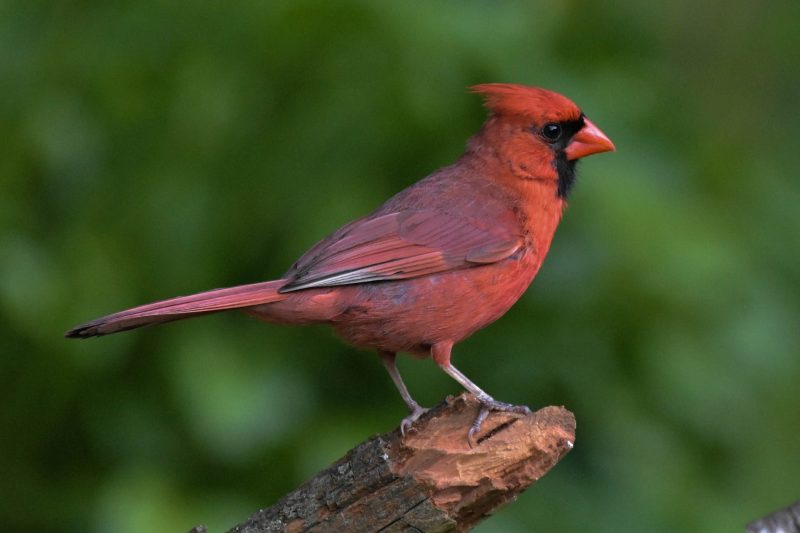
The Northern Cardinal is one of the most recognizable birds in Tennessee, admired for its vivid coloration and melodic whistles. Males are striking with their bright red plumage and black facial mask, while females display a softer brownish hue with red accents on the wings, tail, and crest. Both sexes have a distinctive crest on the head and a thick, orange-red bill, making identification easy even from a distance.
These birds measure about 8 to 9 inches in length, with a wingspan ranging from 10 to 12 inches. They are known for their rich, whistling songs that often sound like “cheer, cheer, cheer” or “birdy, birdy, birdy.” Northern Cardinals are non-migratory and can be spotted year-round, especially at backyard feeders where they are fond of sunflower seeds.
Cardinals thrive in a variety of habitats across Tennessee, including woodlands, gardens, shrublands, and suburban areas. They prefer areas with dense vegetation for nesting and protection. Their widespread presence makes them one of the most beloved backyard birds in the state, symbolizing vibrancy and resilience in all seasons.
American Robin
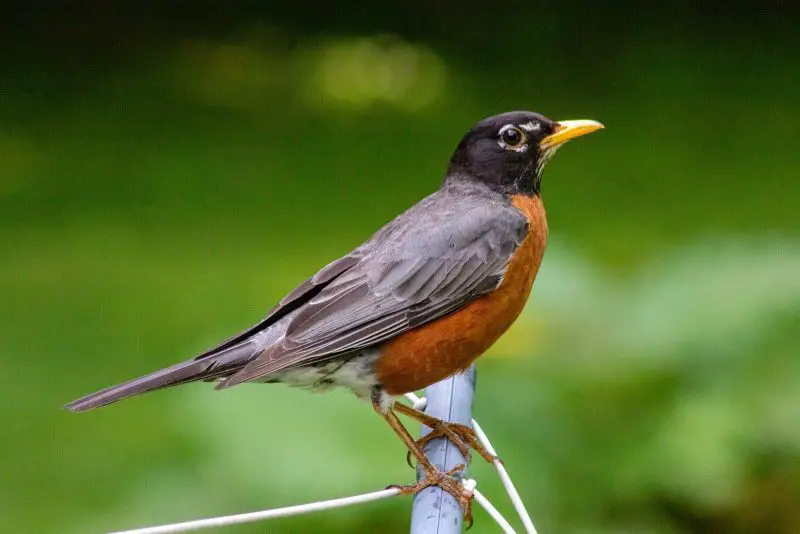
The American Robin is a familiar sight across Tennessee, easily identified by its rusty-orange breast, grayish back, and white eye ring. Males often appear slightly darker than females, but both share the same general features. Their cheerful presence and iconic posture while foraging on lawns make them a common and welcome bird across the region.
Measuring about 9 to 11 inches in length with a wingspan of 12 to 16 inches, the American Robin is a medium-sized thrush. These birds are known for their melodious song, which is often one of the first sounds of spring. They primarily feed on earthworms, insects, and fruits, adjusting their diet with the changing seasons.
In Tennessee, American Robins are widespread in open woodlands, suburban lawns, farmlands, and city parks. They are present year-round, though large flocks may migrate further south during harsh winters. Their adaptability to both rural and urban environments has made them one of the most successful bird species in North America.
Blue Jay
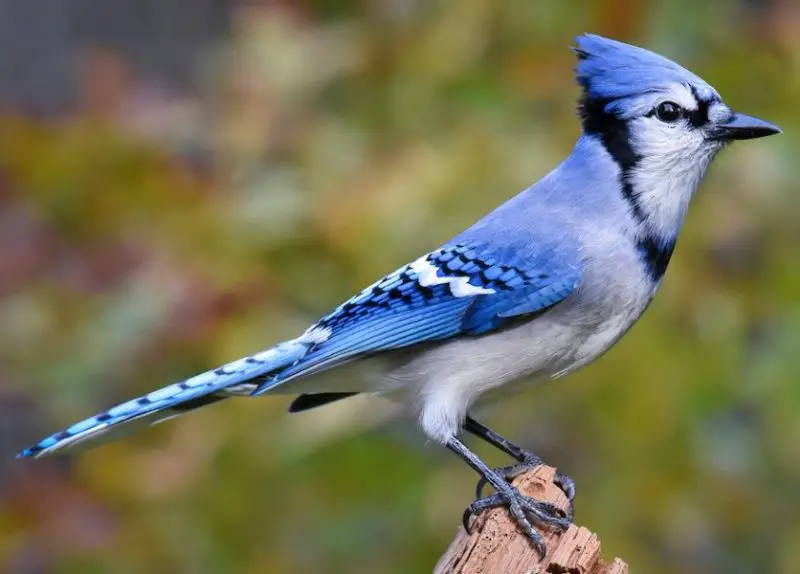
The Blue Jay is a bold and intelligent bird, recognized by its vibrant blue plumage, black necklace-like markings, and white underparts. They also display a prominent crest and striking white wing patches with black barring. Their loud, varied calls, which include harsh “jay-jay” sounds, make them one of the most vocal birds in Tennessee.
These birds measure around 9 to 12 inches long, with a wingspan between 13 and 17 inches. Blue Jays are known for their intelligence, social behavior, and occasional mimicry of hawk calls. Their diet is diverse, including acorns, seeds, nuts, insects, and occasionally small vertebrates. They are also known to cache food for later use.
Blue Jays inhabit forests, woodlands, and suburban neighborhoods throughout Tennessee. They are year-round residents and are especially common in areas with oak trees, which provide one of their favorite food sources. Their strong presence at feeders, combined with their striking colors and bold personality, makes them a memorable sight in both backyards and natural habitats.
Carolina Wren
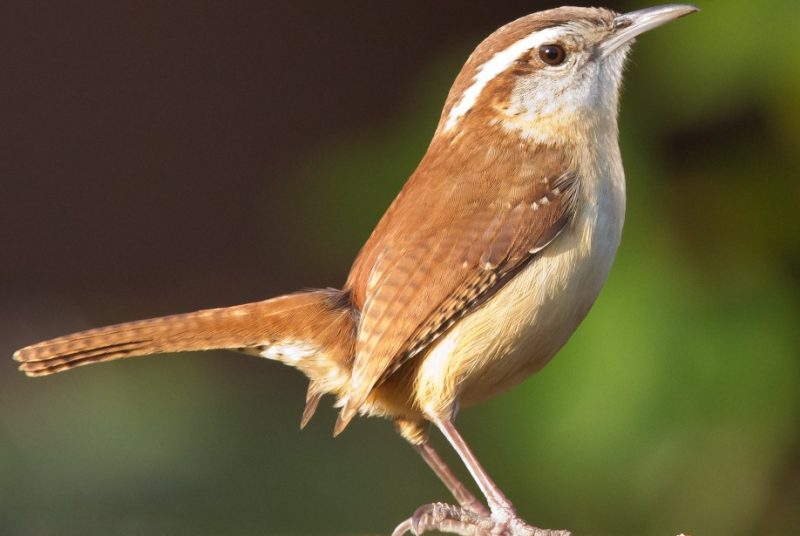
The Carolina Wren is a small but energetic bird that thrives throughout Tennessee. Recognizable by its reddish-brown plumage, bold white eyebrow stripe, and slightly curved bill, it is often more easily heard than seen. Its loud, ringing song, often described as “teakettle-teakettle,” carries across woodlands and gardens, giving away its presence.
This wren measures about 4.7 to 5.5 inches long, with a wingspan of 11 inches, making it one of the smaller songbirds in the state. Despite its size, the Carolina Wren is known for its fearless and inquisitive behavior. It frequently explores nooks, brush piles, and even sheds in search of insects, spiders, and other small invertebrates.
Carolina Wrens are permanent residents in Tennessee, favoring dense shrubs, thickets, and woodland edges. They also adapt well to suburban yards and parks, often nesting in unusual spots like flowerpots or mailboxes. Their adaptability and year-round singing make them a lively and welcome presence across the state.
Mourning Dove
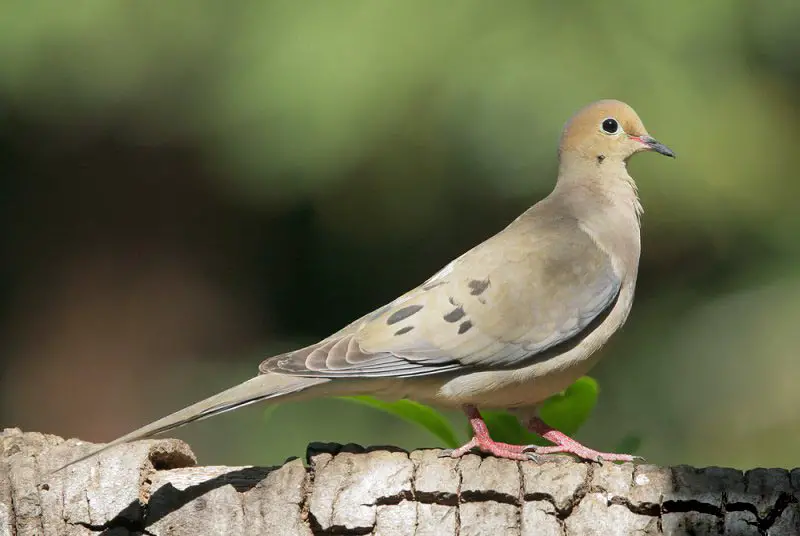
The Mourning Dove is a graceful bird, recognized by its slender body, long pointed tail, and soft grayish-brown plumage with black wing spots. Its mournful cooing call, from which it gets its name, is one of the most distinctive sounds of open fields and suburban areas in Tennessee.
This dove measures about 9 to 13 inches in length, with a wingspan of 17 to 18 inches. Its rapid, whistling wingbeats during takeoff and its gentle demeanor make it easily distinguishable from other birds. Mourning Doves primarily feed on seeds, foraging on the ground in open areas, fields, and backyards where they often gather in pairs or small flocks.
Mourning Doves are abundant across Tennessee and can be found year-round. They inhabit open woodlands, farmlands, grasslands, and suburban landscapes. Their adaptability to human presence and preference for open areas make them one of the most widespread and common birds in the state.
Eastern Bluebird
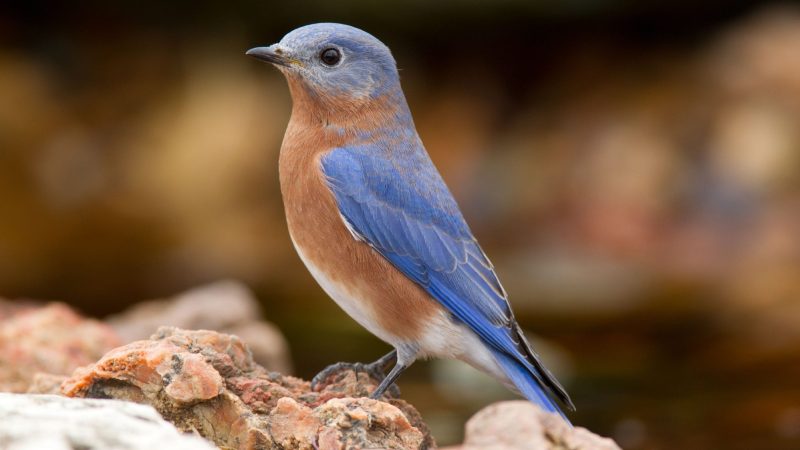
The Eastern Bluebird is a striking species often admired for its vibrant colors and gentle presence in Tennessee. Males are especially beautiful, with bright blue plumage on their wings and back, paired with a rusty-red chest and white belly. Females are more subdued in color, with grayish-blue tones and softer reddish hues, but they share the same elegant form. Their upright posture and vivid appearance make them easy to recognize.
These birds are medium-sized, measuring 6.3 to 8.3 inches in length, with a wingspan of 9.8 to 12.6 inches. Eastern Bluebirds are cavity nesters, often using nest boxes provided by people, which has helped their population recover in many areas. Their song is a soft, melodious warble that adds a cheerful note to fields and open woodlands.
Eastern Bluebirds are common across Tennessee, favoring meadows, orchards, forest edges, and suburban lawns where open areas provide foraging opportunities. They feed primarily on insects and other invertebrates during the warmer months, switching to berries and fruits in winter. Their year-round presence and striking appearance make them a cherished bird for both birdwatchers and homeowners.
Red-bellied Woodpecker
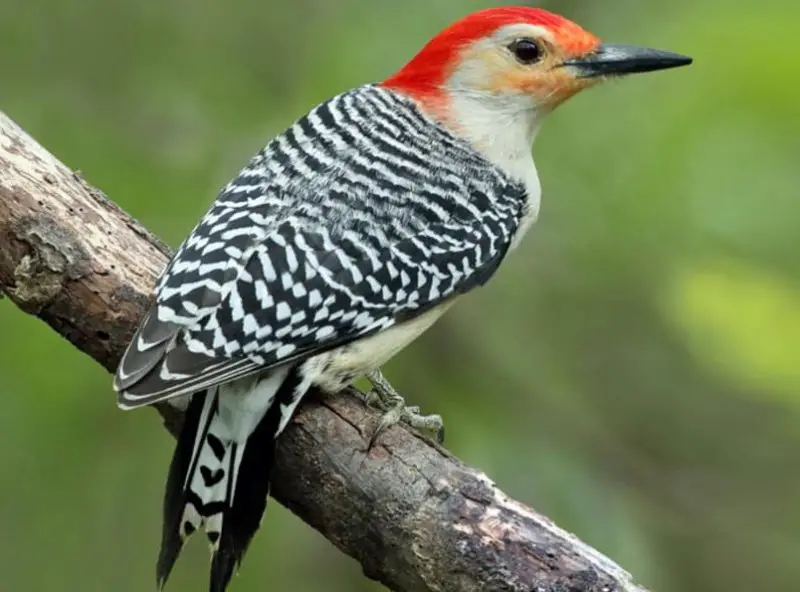
The Red-bellied Woodpecker is a medium-sized bird frequently seen in Tennessee woodlands and backyards. Despite its name, the red patch on the belly is often faint and hard to notice, but the vivid red cap and nape are much more striking. Its black-and-white barred back and pale face give it a distinctive, checkered appearance that helps in quick identification.
These woodpeckers measure about 9 to 10.5 inches long, with a wingspan of 13 to 17 inches. They are agile climbers, using their strong bills to peck at tree bark in search of insects, grubs, and seeds. Their loud “churr” calls and drumming sounds are a familiar part of Tennessee’s forests. They also have the habit of caching food in tree crevices for later use.
Red-bellied Woodpeckers thrive in forests, woodlots, and suburban areas throughout Tennessee. They adapt well to human presence and are frequent visitors to feeders offering suet, nuts, or sunflower seeds. Their bold behavior, striking colors, and year-round activity make them one of the most easily observed and appreciated woodpeckers in the state.
Downy Woodpecker
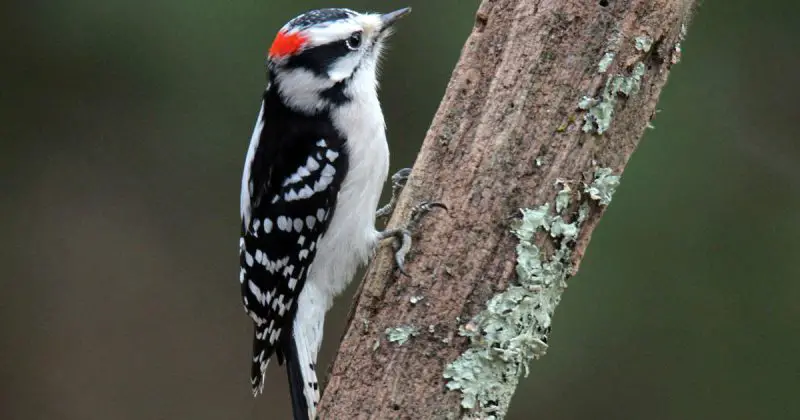
The Downy Woodpecker is the smallest woodpecker in Tennessee, often seen clinging to tree trunks or visiting backyard feeders. Males can be distinguished by a small red patch on the back of the head, while both sexes display black-and-white plumage with a spotted pattern on the wings. Their short bill helps set them apart from similar species.
Downy Woodpeckers measure about 5.5 to 6.7 inches in length, with a wingspan of 9.8 to 11.8 inches. Despite their small size, they are energetic foragers, pecking at bark to uncover insects, larvae, and seeds. They are also known to drum on trees and even metal surfaces, producing a rapid tapping sound that marks their presence.
This species is widely distributed across Tennessee and remains a year-round resident. They thrive in forests, orchards, parks, and backyards, showing remarkable adaptability to different environments. Their frequent visits to feeders and active behavior make them one of the most familiar woodpeckers in suburban landscapes.
Pileated Woodpecker
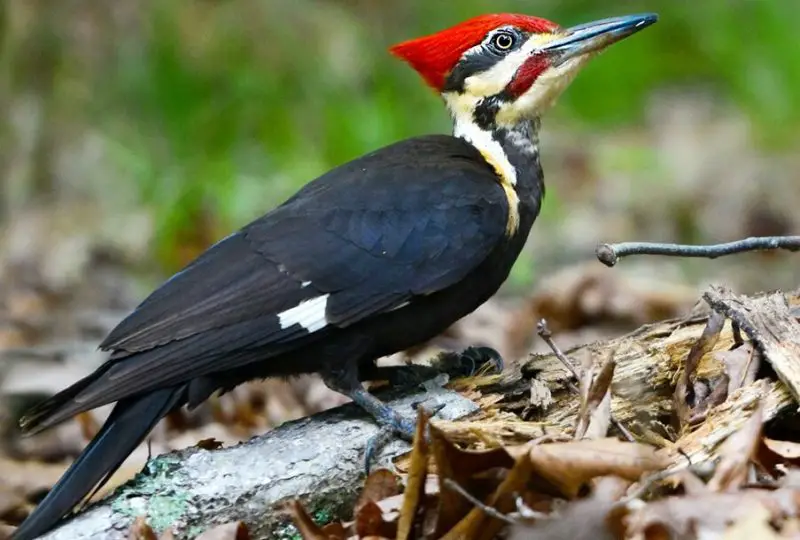
The Pileated Woodpecker is the largest woodpecker found in Tennessee, famous for its striking size and appearance. It has a bold black body, white stripes running down the face and neck, and a spectacular red crest. Males can be identified by a red mustache-like stripe near the bill, while females lack this feature. Their loud calls and powerful drumming can be heard from long distances.
These impressive birds measure about 16 to 19 inches in length, with wingspans stretching up to 29 inches. They use their strong bills to excavate large, rectangular holes in trees while searching for carpenter ants and wood-boring insects, which make up much of their diet. Their feeding activity often leaves distinctive signs in the forest, noticeable to attentive observers.
Pileated Woodpeckers prefer mature forests, wooded swamps, and large tracts of timber across Tennessee. Though not as commonly seen as smaller woodpeckers, their dramatic flight, large size, and unique calls make them unforgettable. They are year-round residents and play a crucial role in forest ecosystems by creating cavities that later provide nesting sites for other wildlife.
Hairy Woodpecker
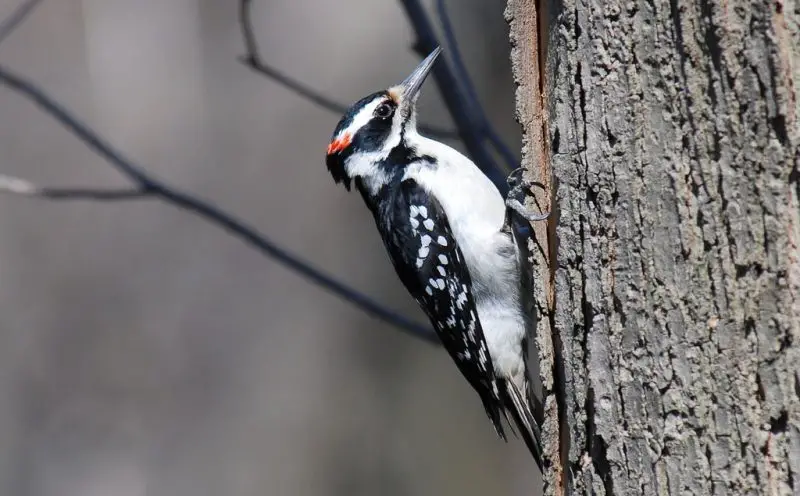
The Hairy Woodpecker closely resembles the Downy Woodpecker but is noticeably larger with a longer, chisel-like bill. Males have a red patch on the back of the head, while both sexes show clean black-and-white plumage with vertical stripes on the head and barred wings. The sharp contrast of their markings makes them relatively easy to spot.
They measure about 7 to 10 inches in length, with a wingspan of 13 to 16 inches. Hairy Woodpeckers feed by pecking into tree bark to find insects, grubs, and larvae, but they also eat seeds and suet when available. Their drumming is strong and deliberate, echoing through wooded areas as a territorial signal.
In Tennessee, Hairy Woodpeckers are found year-round in forests, wooded parks, and even suburban areas with mature trees. While they are less common at feeders than Downy Woodpeckers, they can still be attracted with suet. Their larger size, strong bill, and louder drumming distinguish them from their smaller cousins.
Northern Flicker
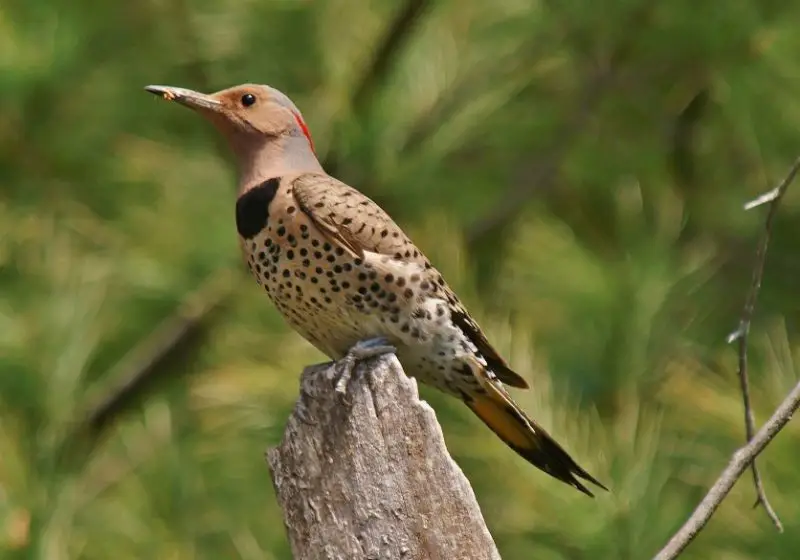
The Northern Flicker is one of the most distinctive woodpeckers in Tennessee, with a brownish body patterned with black spots, bars, and crescents. Unlike most woodpeckers, it spends much of its time on the ground searching for ants, which form a large part of its diet. In Tennessee, the “yellow-shafted” form is most common, with bright yellow underwings and tail feathers visible in flight.
Northern Flickers are fairly large, measuring 11 to 12.2 inches in length, with a wingspan of 16.5 to 20 inches. Males display a black mustache-like marking, while both sexes share the same speckled plumage and striking flight pattern. Their loud “wick-a-wick-a-wick” calls and rapid drumming are familiar sounds in woodlands and open habitats.
These birds are widespread across Tennessee, inhabiting forests, fields, and suburban areas year-round. They are highly adaptable and can often be spotted on lawns probing the ground for ants and beetles. With their unique foraging behavior and vibrant plumage, Northern Flickers add character to the state’s birdlife.
Yellow-bellied Sapsucker
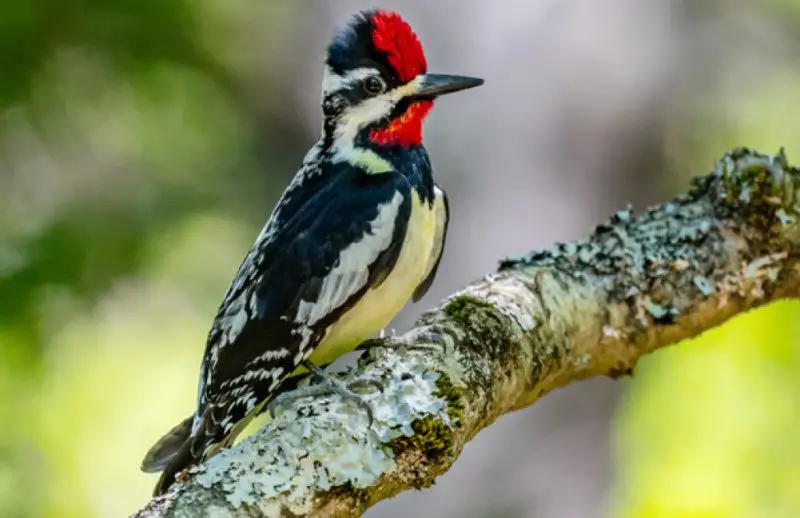
The Yellow-bellied Sapsucker is a medium-sized woodpecker that can be recognized by its bold patterns and specialized feeding habits. Adults have a black-and-white striped face, white wing patches, and a pale yellowish belly. Males have a red crown and throat, while females only show the red crown. Their distinctive behavior of drilling neat rows of holes into trees makes them easy to identify.
They measure about 7.5 to 8.3 inches in length, with a wingspan of 13 to 16 inches. Unlike other woodpeckers that primarily feed on insects, Yellow-bellied Sapsuckers rely heavily on tree sap. They drill small wells in the bark and return frequently to lap up the sap, as well as the insects attracted to it. Their irregular tapping and high-pitched mewing calls are also clues to their presence.
In Tennessee, Yellow-bellied Sapsuckers are mostly seen during the winter months, as they migrate south from their northern breeding grounds. They favor forests, woodlots, and orchards, where suitable trees provide sap. While less common than resident woodpeckers, their unique feeding behavior makes them a fascinating seasonal visitor.
American Crow
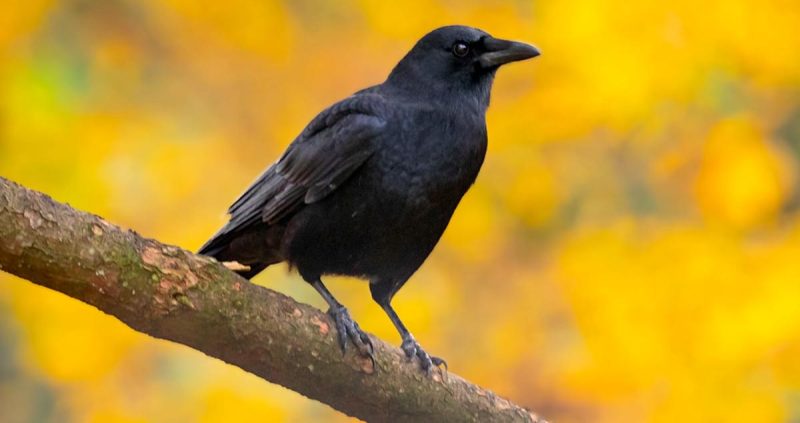
The American Crow is one of the most intelligent and adaptable birds in Tennessee. These large, all-black birds have a glossy sheen, a stout bill, and strong flight with steady wingbeats. Their loud “caw-caw” calls are unmistakable and often heard echoing across both rural and urban landscapes.
Measuring about 16 to 20 inches long with a wingspan of 33 to 39 inches, American Crows are among the larger songbirds. They are highly social, often gathering in large flocks, especially during winter. Known for their problem-solving skills, they use tools, recognize human faces, and communicate complex information within their groups.
Crows are widespread across Tennessee year-round, inhabiting forests, fields, farmlands, towns, and cities. They feed on a wide variety of foods, including insects, seeds, fruits, carrion, and even human leftovers. Their intelligence and adaptability have allowed them to thrive in virtually every habitat across the state.
Common Grackle
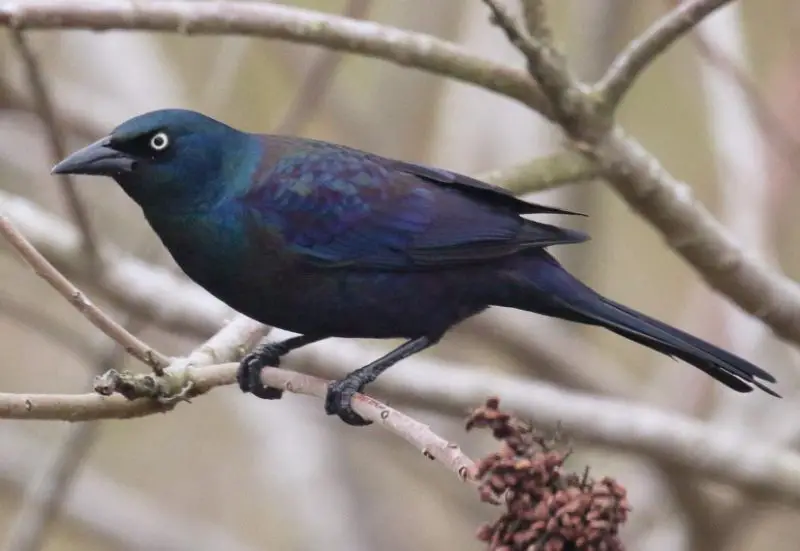
The Common Grackle is a large, bold blackbird with a shimmering, iridescent appearance. Its glossy plumage reflects shades of purple, blue, and green in sunlight, while its long keel-shaped tail and piercing yellow eyes add to its striking look. Males are slightly larger and more iridescent than females but otherwise similar in appearance.
They measure about 11 to 13 inches in length, with a wingspan of 14 to 18 inches. Common Grackles are highly social, often forming noisy flocks that forage together in open fields and urban areas. Their diet is omnivorous, consisting of seeds, grains, insects, and occasionally small animals. Their harsh, metallic-sounding calls are distinct and often heard in large gatherings.
In Tennessee, Common Grackles are present year-round, thriving in open woodlands, farmlands, wetlands, and suburban areas. They are particularly numerous near agricultural fields, where they often feed in large groups. Their adaptability and strong presence in both natural and urban environments make them one of the state’s most noticeable blackbirds.
European Starling

The European Starling is a non-native species in Tennessee, originally introduced from Europe but now widespread across North America. These birds are medium-sized with a glossy black body that shimmers with purple and green iridescence, especially in spring. In winter, they develop white speckling across their feathers, giving them a different seasonal appearance.
Starlings measure about 7.9 to 9 inches long with a wingspan of 12 to 16 inches. They are strong fliers and often form massive flocks called murmurations, which create dazzling patterns in the sky. Their vocalizations are varied, including whistles, chatters, and even mimicry of other birds. They feed on insects, fruits, grains, and scraps, making them highly opportunistic.
European Starlings are abundant across Tennessee year-round and thrive in both rural and urban areas. They prefer open fields, farmlands, and cities, often nesting in cavities or man-made structures. Though sometimes considered pests for their aggressive nesting habits, their adaptability and dramatic flocking behavior make them a striking part of Tennessee’s birdlife.
House Sparrow
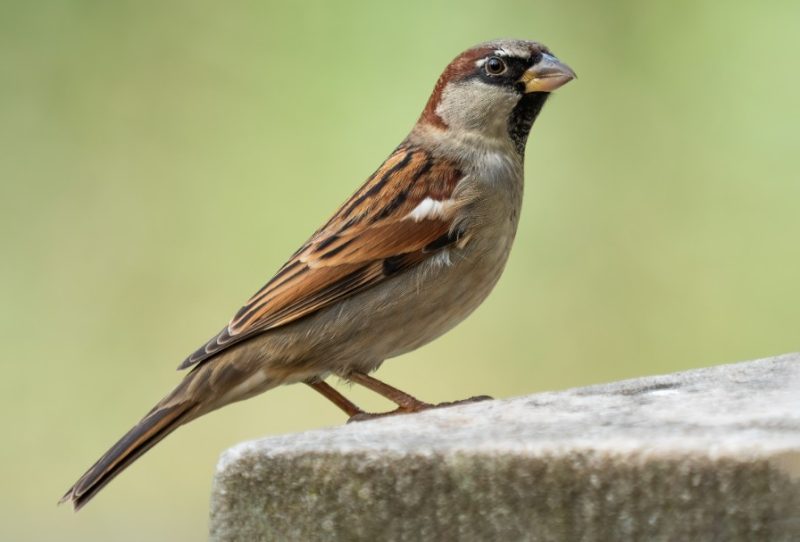
The House Sparrow is another non-native bird in Tennessee, introduced from Europe in the 19th century. Males can be recognized by their gray crown, chestnut nape, black bib, and streaked brown wings, while females are more uniformly brown and streaky. Despite their small size, they are bold and highly visible around human settlements.
They measure about 5.9 to 6.7 inches in length, with a wingspan of 7.5 to 9.8 inches. House Sparrows are social birds that often live in flocks, chattering noisily as they forage for seeds, grains, and crumbs near people. Their short, repetitive chirps and constant activity make them easy to detect in towns and cities.
House Sparrows are present year-round in Tennessee, mostly concentrated in urban and suburban environments. They nest in cavities, crevices, and building structures, often competing with native species for nesting sites. Although not native, their close association with people has made them one of the most common birds across the state.
Song Sparrow
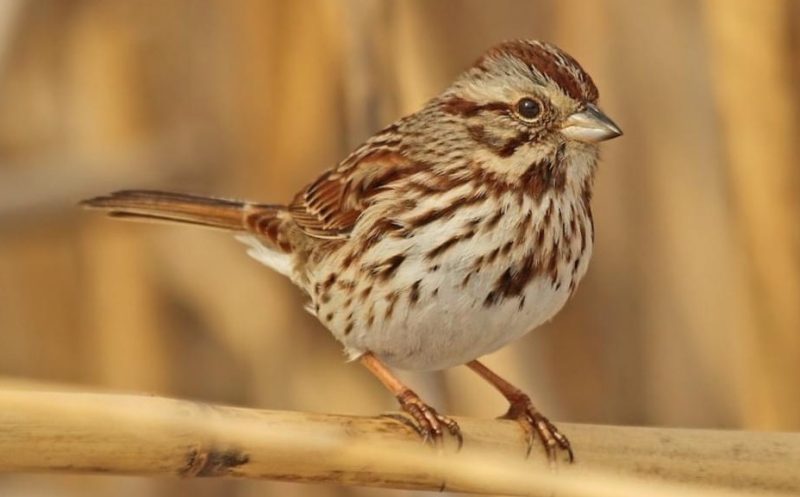
The Song Sparrow is a familiar and widespread bird in Tennessee, known for its streaked brown plumage and melodious singing. They have a brown crown, a gray face with a dark eye stripe, and a heavily streaked breast with a central dark spot. Their earthy colors help them blend into brushy habitats, but their persistent singing often reveals their presence.
They measure about 4.7 to 6.7 inches long, with a wingspan of 7.1 to 9.4 inches. Song Sparrows are aptly named for their rich and varied song, which includes a series of clear notes followed by trills. They feed mainly on seeds and insects, foraging on the ground or low vegetation. Their adaptable nature allows them to thrive in a wide range of habitats.
In Tennessee, Song Sparrows are common year-round residents, inhabiting fields, gardens, forest edges, and wetlands. They are particularly abundant in shrubby or grassy areas where they can find both food and cover. Their beautiful songs and adaptability make them one of the most appreciated sparrows in the state.
White-throated Sparrow
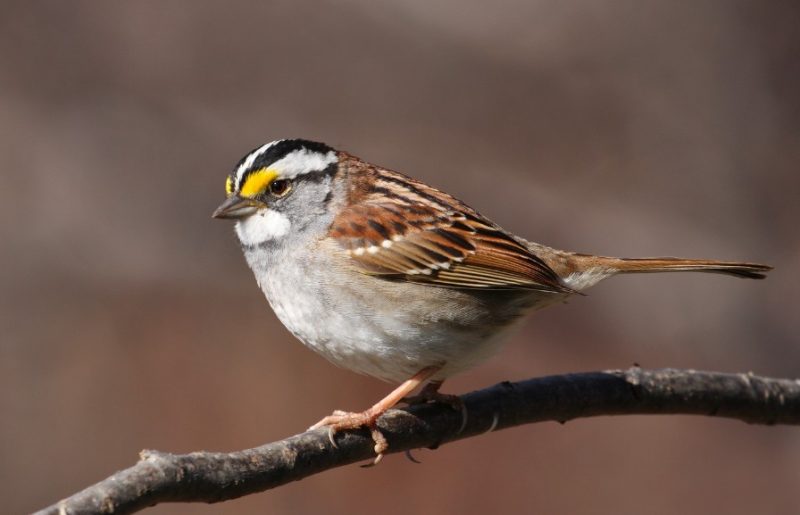
The White-throated Sparrow is a distinctive winter visitor in Tennessee, recognized by its crisp markings and sweet whistling song. Adults have gray breasts, brown streaked backs, and striking head patterns. The most notable features are the bright white throat patch and the head stripes, which can appear either white-and-black or tan-and-brown. Their clear song often sounds like “Old Sam Peabody, Peabody, Peabody.”
These sparrows measure about 6.3 to 7.1 inches in length, with a wingspan of 7.9 to 9.1 inches. They forage mostly on the ground, scratching with both feet to uncover seeds, insects, and berries. White-throated Sparrows are social, often joining mixed winter flocks where their crisp plumage and bold calls make them stand out.
In Tennessee, they are most common from late fall through early spring, migrating northward for breeding during summer. They favor brushy edges, woodland clearings, and backyard feeders, especially when seed is available. Their striking markings and cheerful song make them a welcome seasonal presence.
Chipping Sparrow
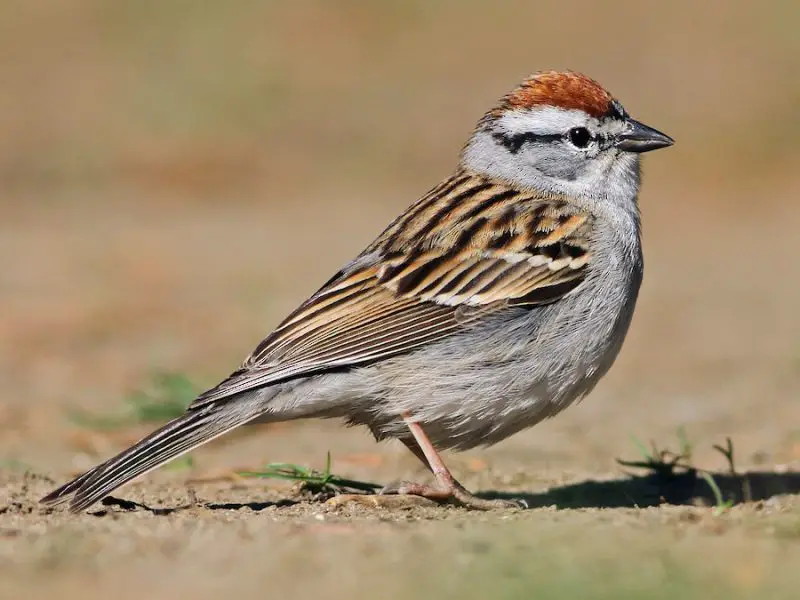
The Chipping Sparrow is a small, slender bird with a neat appearance and cheerful trills that brighten spring and summer days in Tennessee. Adults in breeding plumage display a rusty-red cap, a clean gray breast, and a bold black eye stripe. Outside of breeding season, they appear paler and more streaked but remain recognizable by their slim form and steady behavior.
They measure about 4.7 to 5.9 inches in length, with a wingspan of 8.3 inches. Chipping Sparrows forage on the ground and in low vegetation, feeding mainly on seeds and small insects. Their distinctive song is a long, dry trill, easily heard in open spaces such as lawns and parks.
These sparrows are widespread across Tennessee during spring and summer, nesting in trees and shrubs in open woodlands, gardens, and suburban neighborhoods. In winter, some remain in the state, though their numbers decline as many migrate south. Their adaptability and friendly presence at feeders make them a familiar backyard bird.
Dark-eyed Junco
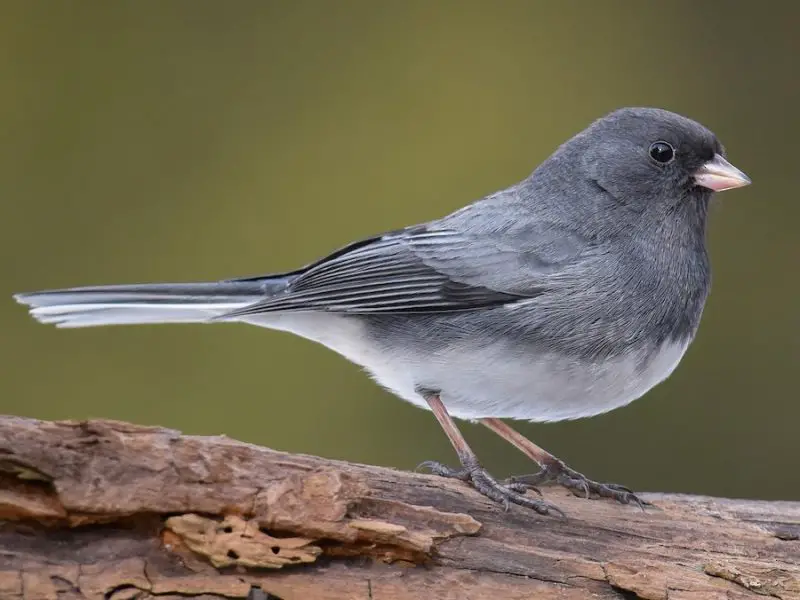
The Dark-eyed Junco is a winter resident in Tennessee, often called “snowbirds” for their arrival with cold weather. They are small sparrows with a slate-gray back and head, white belly, and flashing white outer tail feathers that are visible in flight. Females and immatures often appear browner than males, but the crisp color contrast remains distinctive.
These birds measure about 5.5 to 6.3 inches long, with a wingspan of 7.1 to 9.8 inches. Dark-eyed Juncos forage primarily on the ground, hopping and scratching for seeds and insects. They are active, quick-moving birds, often seen in flocks during the winter months. Their high-pitched chip notes are common background sounds in woodlands and backyards.
In Tennessee, Juncos are primarily winter visitors, inhabiting woodlands, brushy edges, and suburban yards. They are frequent guests at feeders, especially when millet or sunflower seeds are offered on the ground. Their seasonal arrival brings a lively presence to the state’s colder months.
Eastern Towhee
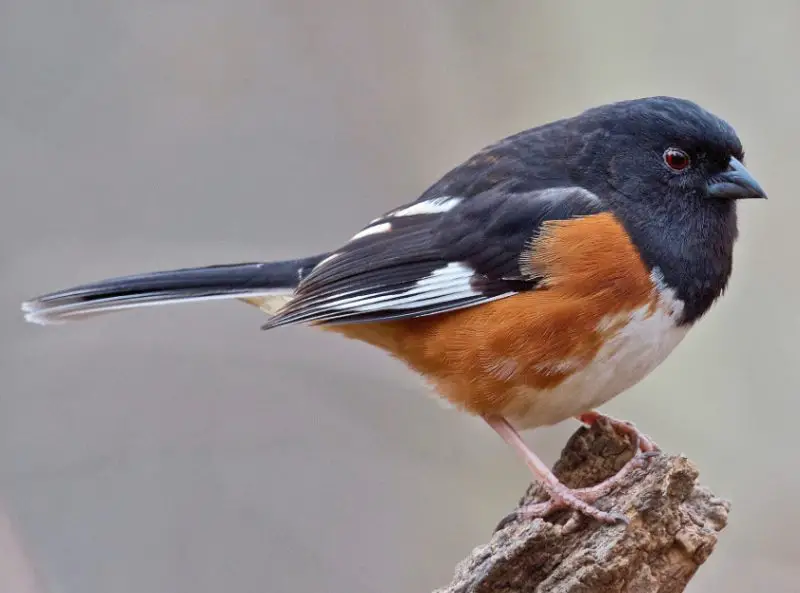
The Eastern Towhee is a striking and vocal bird with bold plumage and a loud, distinctive call. Males have jet-black heads, backs, and tails with white bellies and rufous sides, while females show the same pattern in brown rather than black. Their call sounds like “drink-your-tea,” a clear phrase that carries across their habitats.
They measure about 6.8 to 8.2 inches long, with a wingspan of 7.9 to 11 inches. Eastern Towhees forage mostly on the ground, scratching through leaf litter with vigorous double-footed hops. Their diet consists of seeds, insects, berries, and other plant matter, shifting seasonally to match available food.
Eastern Towhees are found year-round throughout Tennessee, especially in shrubby fields, forest edges, and thickets. They are shy but vocal, often heard before being seen. Their striking coloration and lively behavior make them a memorable and easily recognized bird in the state.
Indigo Bunting
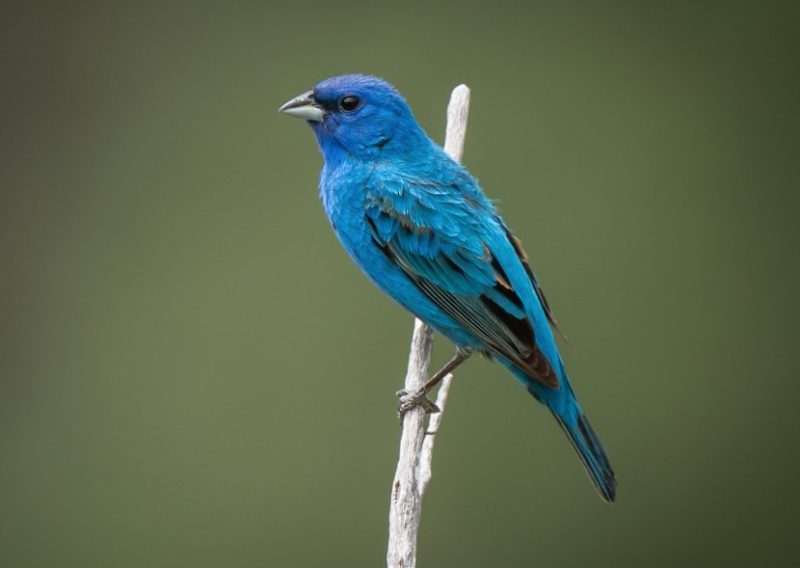
The Indigo Bunting is a dazzling songbird, especially in summer when males glow with bright, iridescent blue plumage. Females, by contrast, are warm brown with faint streaking, helping them stay hidden while nesting. This strong sexual dimorphism makes the males stand out dramatically against green summer foliage.
These buntings measure about 4.7 to 5.1 inches long, with a wingspan of 7.5 to 8.7 inches. Males perch conspicuously to sing their cheerful, paired notes during breeding season. Their diet is primarily seeds, insects, and berries, and they are frequently seen foraging along field edges and hedgerows.
In Tennessee, Indigo Buntings are summer residents, arriving in spring to breed and migrating south for the winter. They prefer brushy habitats, woodland borders, and overgrown fields, often nesting in low shrubs. Their vivid coloration and sweet songs make them one of the most striking summer birds in the region.
American Goldfinch
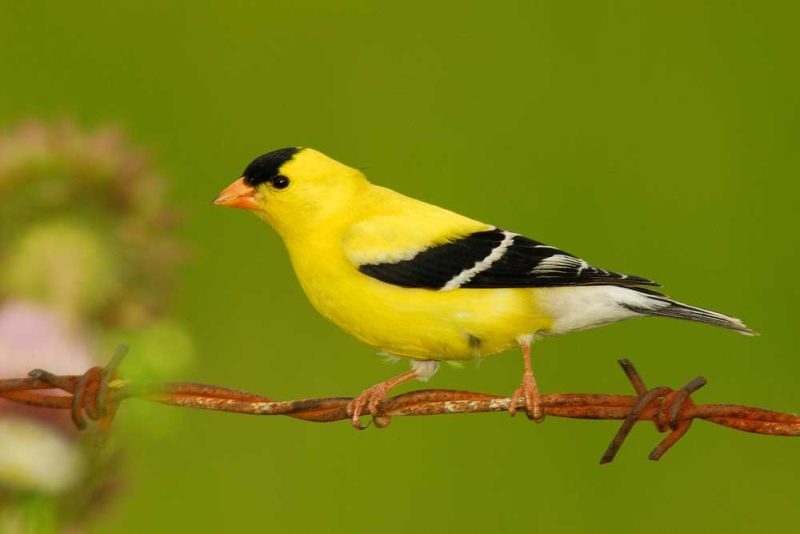
The American Goldfinch is a bright and lively bird, especially striking in summer when males wear brilliant yellow plumage with black wings, tail, and cap. Females and winter birds are duller, with olive or brownish tones, but retain the same small size and conical bill. Their bounding flight and sweet calls make them easy to spot.
These finches measure about 4.3 to 5.1 inches long, with a wingspan of 7.5 to 8.7 inches. Unlike many songbirds, American Goldfinches breed late in the summer, often timed with the abundance of thistle seeds. They are acrobatic feeders, frequently hanging upside down on seed heads or visiting feeders filled with nyjer seed.
In Tennessee, American Goldfinches are year-round residents, although their numbers increase in winter when flocks form. They inhabit fields, meadows, gardens, and suburban yards, bringing bright color and cheerful calls to the landscape. Their vibrant plumage and friendly feeder habits make them favorites among birdwatchers.
House Finch
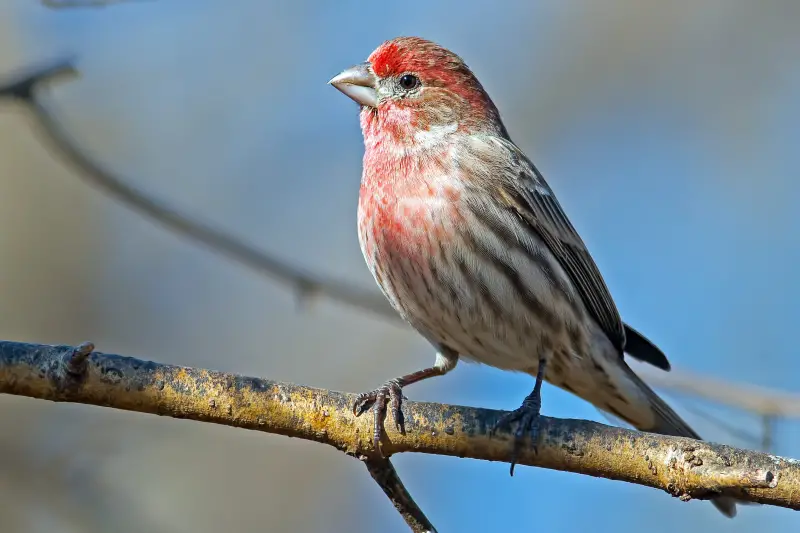
The House Finch is a small, colorful bird commonly found in Tennessee. Males display a rosy-red head, throat, and chest, which contrasts with their brown streaked back and belly. Females are more subdued, with streaked brown plumage and no red, making them less conspicuous. Their cheerful presence and melodious warbling songs make them easily recognizable in residential areas.
House Finches measure about 5 to 6 inches in length, with a wingspan of 7.5 to 9.8 inches. They are active foragers, feeding on seeds, fruits, and buds. Males often perch openly to sing a series of warbling notes, while both sexes are frequently seen at feeders, enjoying sunflower seeds or nyjer.
In Tennessee, House Finches are year-round residents, thriving in urban and suburban environments, as well as open woodlands and farmlands. Their adaptability to human-altered landscapes and vibrant plumage have made them one of the most common and familiar finches in the state.
Purple Finch
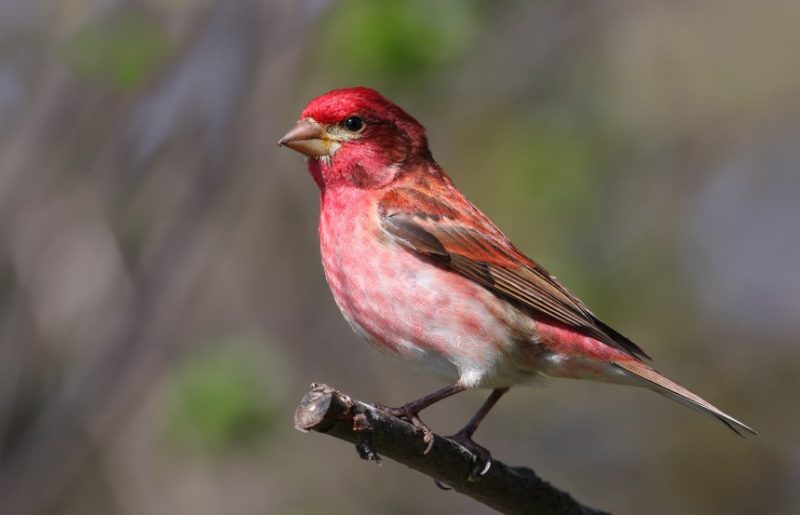
The Purple Finch is a medium-sized finch with a striking raspberry-red coloration on the head, chest, and back of males, while females are brown and heavily streaked. Their large, strong bill and relatively chunky body distinguish them from similar finches. Their song is a rich, warbling melody that fills woodlands and forest edges.
They measure about 5 to 6 inches in length, with a wingspan of 8 to 10 inches. Purple Finches feed primarily on seeds, buds, and insects, often foraging in trees and shrubs. They are agile and can be seen clinging to branches or hopping along twigs in search of food.
In Tennessee, Purple Finches are mostly seen in winter as migratory visitors from the north, though small numbers may remain year-round in wooded areas. They inhabit coniferous and mixed forests, as well as backyard feeders, where their bright coloration and lively song make them easy to identify.
Baltimore Oriole
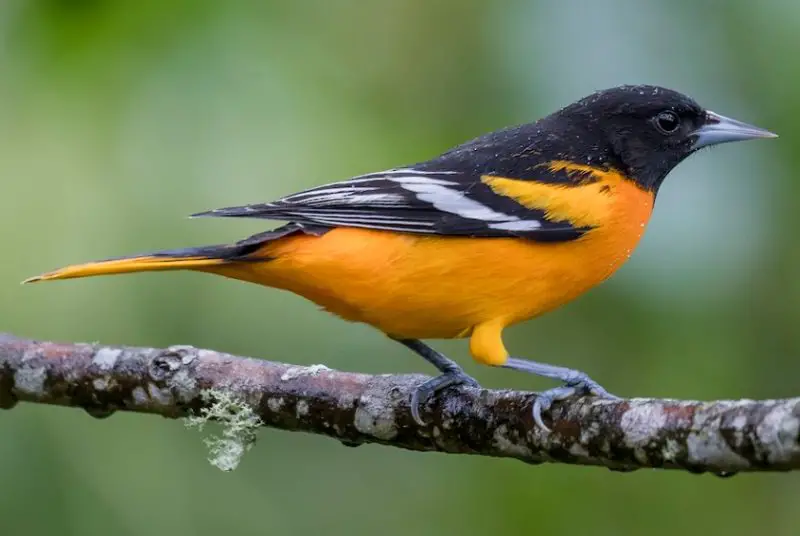
The Baltimore Oriole is a striking, medium-sized songbird with brilliant orange and black plumage in males. Females are more muted, with yellow-orange underparts and olive-brown upperparts. Their long, pointed bills are ideal for feeding on nectar, fruit, and insects. Orioles are also known for their intricate hanging nests woven from fibers.
Baltimore Orioles measure about 6.7 to 7.5 inches long, with a wingspan of 9.8 to 12 inches. They are often seen flitting through trees or visiting feeders with oranges and nectar. Their flute-like song and whistled calls make them a cheerful presence in Tennessee’s spring and summer.
In Tennessee, Baltimore Orioles are summer residents, arriving in spring to breed in open woodlands, forest edges, and suburban parks. They are highly visible during nesting season and are a favorite of birdwatchers for their vivid colors and melodious songs.
Orchard Oriole
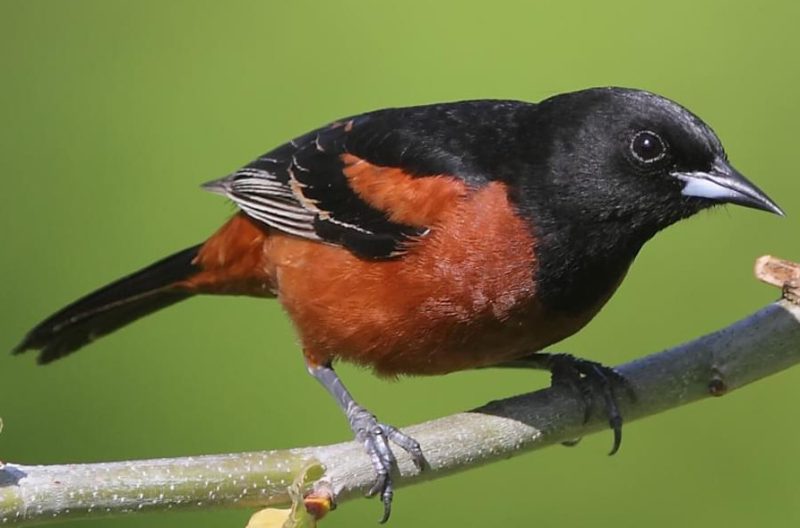
The Orchard Oriole is slightly smaller than the Baltimore Oriole and displays a rich chestnut body with a black head and throat in males. Females and immature birds are yellow-green with darker wings, providing a subtler appearance. Their slender form and pointed bill distinguish them from similar orioles, and they have a soft, rich song.
Orchard Orioles measure about 5.5 to 6 inches in length, with a wingspan of 8.7 to 10.6 inches. They forage for insects, fruits, and nectar, often feeding among trees and shrubs in orchards, open woodlands, and gardens. Their flight is strong and direct, and they often move in small flocks outside the breeding season.
In Tennessee, Orchard Orioles are summer visitors, breeding primarily in the western and central parts of the state. They prefer open habitats with scattered trees, orchards, and riparian edges. Their vivid colors and slender form make them a striking sight in suitable habitats.
Red-winged Blackbird
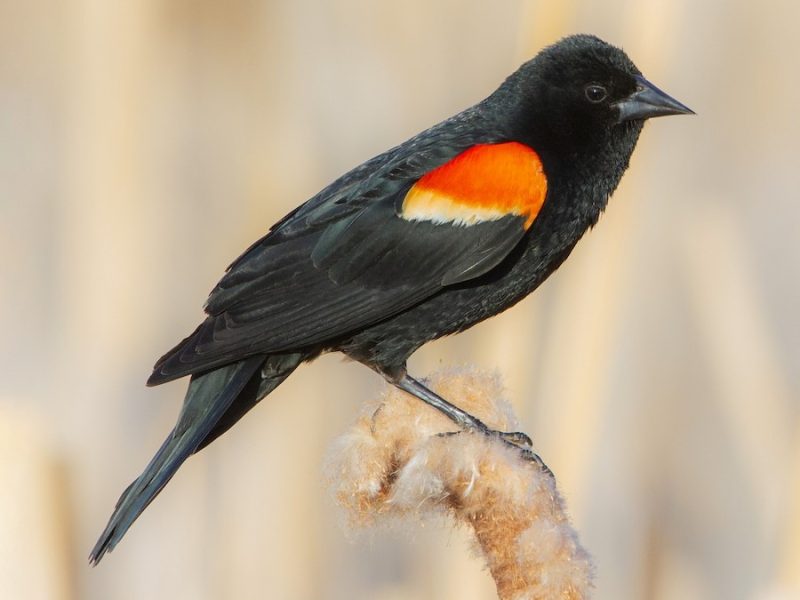
The Red-winged Blackbird is a medium-sized, highly territorial bird widely recognized by the bright red and yellow shoulder patches on males. Females are heavily streaked in brown, providing camouflage among reeds and grasses. Their harsh, rattling calls are iconic and often heard across marshes and fields.
They measure about 7.5 to 9 inches in length, with a wingspan of 12 to 16 inches. Red-winged Blackbirds feed on seeds, insects, and grains, foraging on the ground or perched on vegetation. Males aggressively defend territories during the breeding season, while females build nests concealed in marsh vegetation or shrubs.
Red-winged Blackbirds are abundant in Tennessee year-round, inhabiting wetlands, marshes, pastures, and agricultural fields. Their striking shoulder patches, distinctive calls, and large flocks make them one of the most easily observed and characteristic birds of open landscapes in the state.
Brown-headed Cowbird
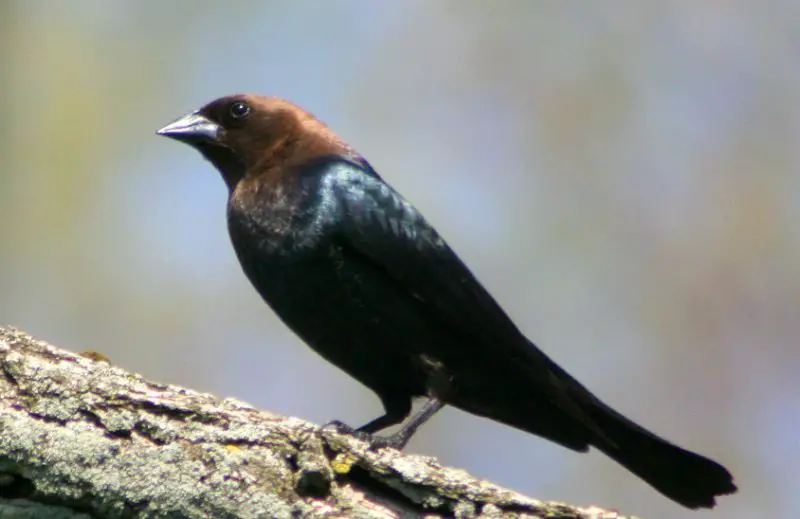
The Brown-headed Cowbird is a small, stocky blackbird with a glossy black body and rich brown head in males, while females are duller and streaked brown. They are unique for their brood-parasitic behavior, laying eggs in the nests of other birds rather than building their own. Their vocalizations include a high-pitched “gluee” call.
They measure about 7.5 to 9 inches long, with a wingspan of 12 to 15 inches. Cowbirds forage primarily on the ground, feeding on seeds and insects. Their behavior is often opportunistic, following grazing animals or flocks of other birds to feed on disturbed insects.
Brown-headed Cowbirds are widespread across Tennessee year-round, found in pastures, open woodlands, edges of forests, and suburban areas. Their distinctive appearance and unique reproductive strategy make them a notable presence, though sometimes controversial due to their parasitic nesting habits.
Eastern Meadowlark

The Eastern Meadowlark is a striking grassland bird recognized for its bright yellow underparts and bold black “V” on the chest. Its back and wings are streaked brown, allowing it to blend with tall grasses while foraging. Meadowlarks are also known for their melodious, flute-like song that carries across open fields in Tennessee.
They measure about 8.7 to 11 inches in length, with a wingspan of 15.7 to 16.5 inches. Eastern Meadowlarks primarily feed on insects, seeds, and grains, often foraging on the ground. They are territorial during the breeding season, with males singing from elevated perches or fence posts to defend their area.
Eastern Meadowlarks inhabit grasslands, pastures, prairies, and agricultural fields throughout Tennessee. Their preference for open habitats and conspicuous songs make them one of the most characteristic birds of the state’s rural landscapes.
Eastern Phoebe
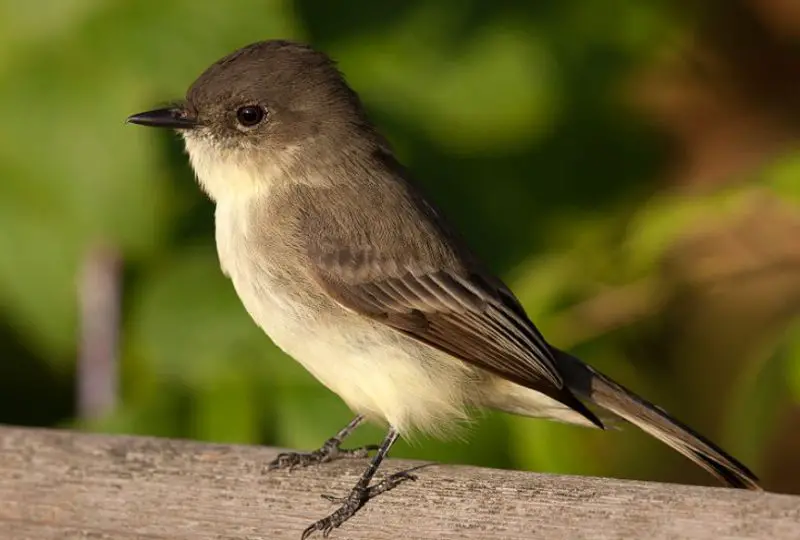
The Eastern Phoebe is a small, slender flycatcher with a gray-brown back, whitish underparts, and a slight olive tint on the sides. Unlike many colorful birds, its subtle plumage is contrasted by its constant tail-wagging behavior, which is a key identification trait. Phoebes are known for their sharp “fee-bee” call, which gives them their name.
They measure about 5.5 to 6.3 inches in length, with a wingspan of 9.8 to 11 inches. Eastern Phoebes feed primarily on flying insects, often sallying out from perches to catch prey mid-air. They build open cup-shaped nests under bridges, eaves, and other human structures, demonstrating a remarkable tolerance for human proximity.
In Tennessee, Eastern Phoebes are common year-round in some regions but more prevalent during the breeding season. They inhabit open woodlands, farmland edges, and suburban areas, making their presence familiar to both rural and city residents.
Eastern Kingbird

The Eastern Kingbird is a bold, black-and-white flycatcher known for its aggressive territorial behavior. Males have dark gray to black upperparts and a white belly, with a distinctive white tip on the tail. Their loud, sharp “kip” calls and fierce chasing of intruders make them highly noticeable in Tennessee’s open habitats.
They measure about 7.1 to 8.3 inches in length, with a wingspan of 12.6 to 14.2 inches. Eastern Kingbirds feed almost exclusively on flying insects, which they catch with swift aerial maneuvers. Their nesting habits include open cup-shaped nests in trees or shrubs, often in areas with clear sightlines to detect predators.
Eastern Kingbirds are summer residents throughout Tennessee, favoring open fields, forest edges, and farmlands. Their striking behavior, vocalizations, and willingness to chase larger birds make them a dramatic and fascinating species to observe.
Great Crested Flycatcher
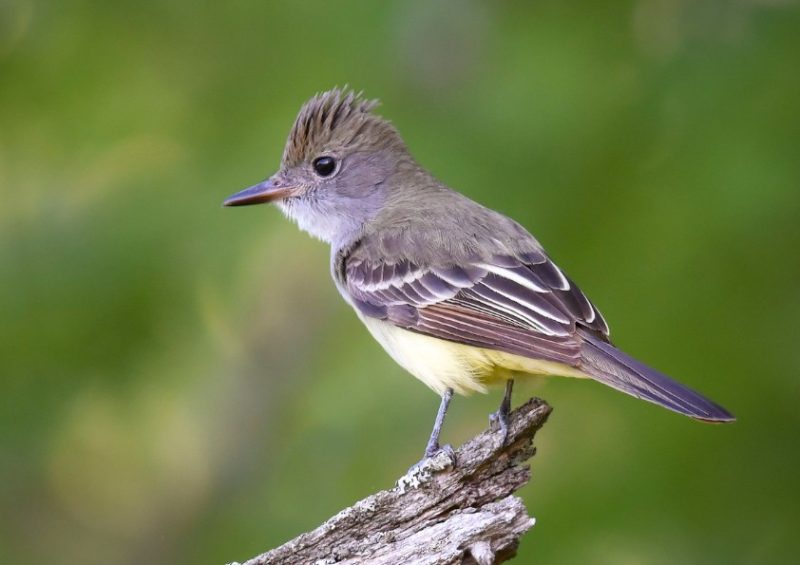
The Great Crested Flycatcher is a large, robust flycatcher with olive-brown upperparts, bright yellow underparts, and a gray throat. A rusty-colored tail and crest help distinguish it from other flycatchers in Tennessee. Known for its loud, rolling “whee-eep” call, it is often more easily heard than seen.
These birds measure about 7.5 to 9 inches long, with a wingspan of 12 to 14 inches. Great Crested Flycatchers feed on insects, fruits, and occasionally small vertebrates. They frequently nest in tree cavities or man-made boxes, lining the nest with feathers, fur, and plant fibers.
In Tennessee, Great Crested Flycatchers inhabit woodlands, forest edges, and suburban parks. They are common summer residents, often seen perched high in trees, scanning for insects, and defending territories with energetic calls.
Ruby-throated Hummingbird
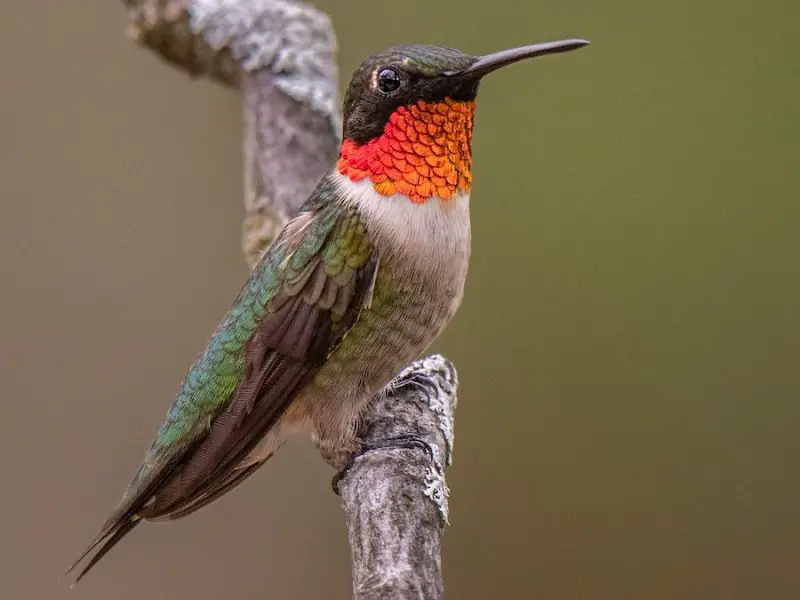
The Ruby-throated Hummingbird is a tiny, dazzling bird famous for its iridescent green back and brilliant red throat in males. Females are green on the back with whitish underparts and lack the bright throat patch. Their rapid wingbeats produce a humming sound that is instantly recognizable in Tennessee gardens and woodlands.
They measure about 3 to 3.5 inches long, with a wingspan of 3.1 to 4.3 inches. These hummingbirds feed on nectar from flowers and feeders, as well as small insects and spiders for protein. They are highly territorial during the breeding season, fiercely defending feeding territories against intruders.
Ruby-throated Hummingbirds are summer residents throughout Tennessee, migrating from Central America to breed. They favor flowering gardens, woodland edges, and meadows. Their brilliance, agility, and delicate hovering make them a favorite among birdwatchers and gardeners alike.
Chimney Swift
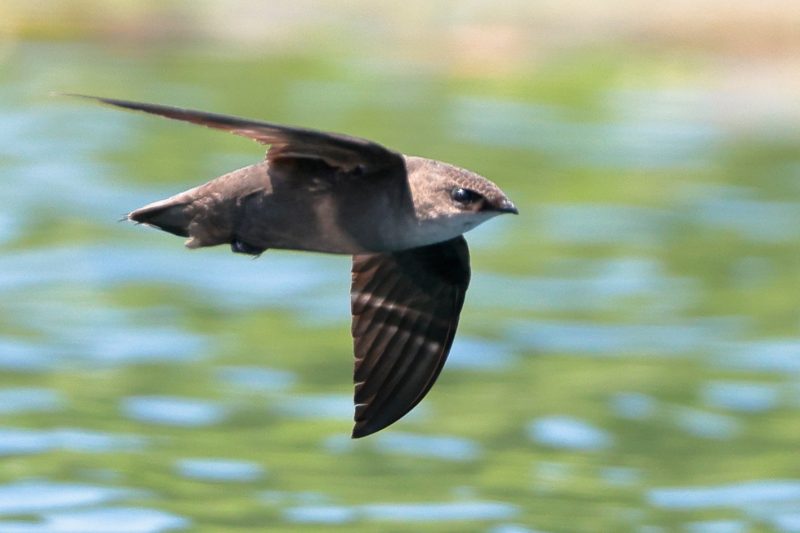
The Chimney Swift is a small, cigar-shaped bird with dark sooty brown plumage and long, narrow wings that allow rapid, acrobatic flight. They are almost never seen perched except on vertical surfaces such as chimneys, where they roost and nest. Their high-pitched, twittering calls fill the air during evening flights in Tennessee.
Chimney Swifts measure about 5 inches long, with a wingspan of 11 inches. They feed exclusively on flying insects, catching them mid-air with remarkable agility. Their distinctive twirling flight pattern and constant movement are key identifying traits.
Chimney Swifts are summer residents in Tennessee, nesting in chimneys, hollow trees, and other vertical cavities. They are commonly seen over towns, rivers, and fields, especially during late afternoon and evening feeding flights. Their presence is a hallmark of warm summer evenings in the state.
Barn Swallow
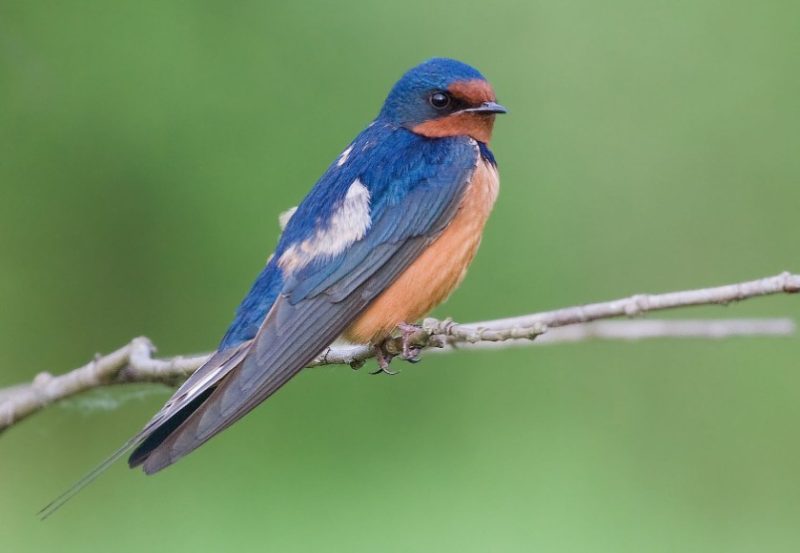
The Barn Swallow is a sleek, acrobatic bird recognized by its long, deeply forked tail and glossy blue-black upperparts. Its chest and underparts are a warm reddish-brown, and its face has a subtle reddish throat patch. Known for its graceful flight and swift aerial maneuvers, the Barn Swallow is a common sight across Tennessee.
They measure about 5.5 to 7 inches in length, with a wingspan of 11 to 13 inches. Barn Swallows feed almost exclusively on flying insects, catching them on the wing with incredible precision. They often build mud nests on man-made structures such as barns, bridges, and eaves, which gives them their name.
Barn Swallows are summer residents in Tennessee, breeding widely throughout open fields, farmlands, and suburban areas. They are highly social, often seen in flocks and performing aerial displays. Their presence is a welcome sign of warm months and abundant insect life.
Tree Swallow
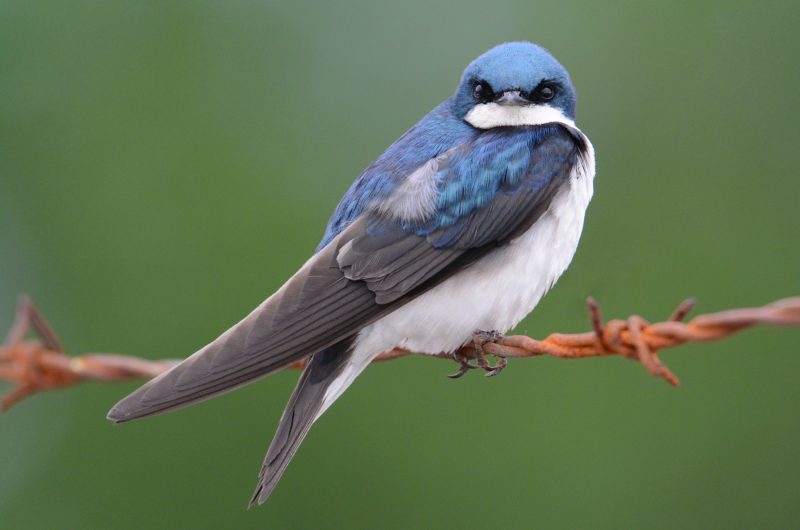
The Tree Swallow is a medium-sized swallow with iridescent blue-green upperparts and bright white underparts. Their slender body and slightly forked tail make them agile fliers. They are often seen hovering over water or open fields, catching insects on the wing with acrobatic skill.
They measure about 5 to 6 inches in length, with a wingspan of 11 to 13 inches. Tree Swallows are cavity nesters, frequently using old woodpecker holes or nest boxes. Their diet consists mainly of flying insects, but they also consume small berries in the fall and winter.
In Tennessee, Tree Swallows are summer residents, inhabiting wetlands, ponds, and open fields where suitable nesting sites exist. Their swift, gliding flight and contrasting coloration make them easily distinguishable among other swallows.
Carolina Chickadee
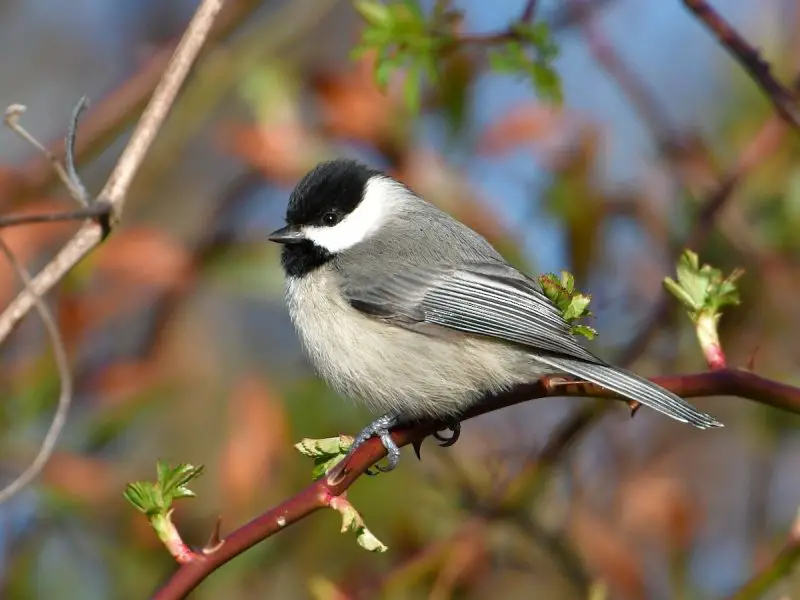
The Carolina Chickadee is a small, energetic bird with a black cap and bib, white cheeks, and soft gray upperparts. Its underparts are lighter gray, and its short tail and rounded body give it a distinctive, plump appearance. These chickadees are known for their curious nature and distinctive “chick-a-dee-dee-dee” calls.
They measure about 4.7 inches in length, with a wingspan of 6.3 to 7.9 inches. Carolina Chickadees feed on insects, seeds, and berries, often hanging upside down from branches while foraging. They are highly social outside the breeding season, forming small flocks and joining mixed-species groups.
Carolina Chickadees are year-round residents throughout Tennessee, favoring deciduous forests, woodland edges, and suburban gardens. Their friendly behavior, acrobatic movements, and cheerful calls make them one of the most beloved backyard birds.
Black-capped Chickadee (in higher elevations)
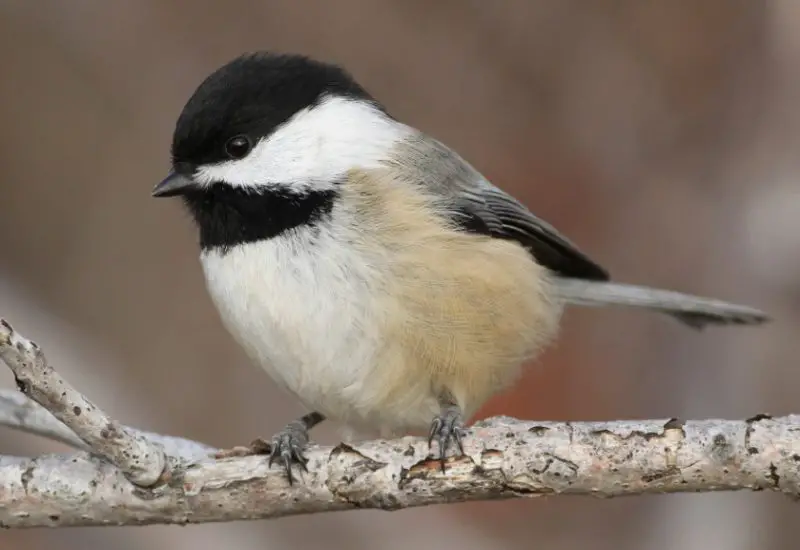
The Black-capped Chickadee closely resembles the Carolina Chickadee but is slightly larger with more contrasting black-and-white head markings. Their gray back and light underparts are similar, but subtle differences in call notes can distinguish the two species. They are hardy birds adapted to cooler, higher elevation habitats in Tennessee.
They measure about 4.7 to 5.5 inches long, with a wingspan of 7.1 to 8.7 inches. Like other chickadees, they feed on insects, seeds, and berries, often caching food for later use. Their familiar “chick-a-dee-dee-dee” call varies by region, providing clues to their presence.
In Tennessee, Black-capped Chickadees are found primarily in the higher elevations of the Cumberland Plateau and Smoky Mountains. They inhabit mixed forests, coniferous woodlands, and montane habitats, where their vocalizations and curious behavior make them a noticeable and entertaining species.
Cedar Waxwing
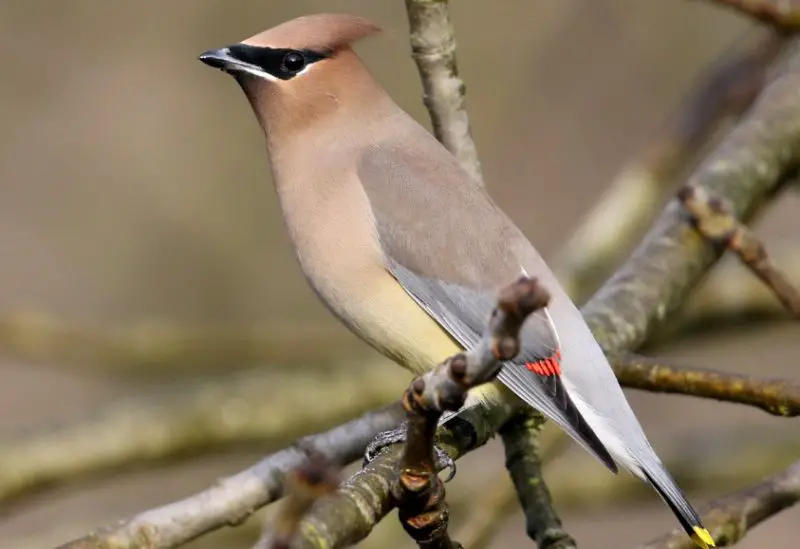
The Cedar Waxwing is a sleek, silky bird with a pale brown head and chest, fading into soft gray on the back and wings, and bright yellow tips on the tail. A black mask across the eyes and small red waxy tips on the wing feathers make this species unmistakable. They are known for their social behavior and acrobatic flight.
They measure about 6 to 7 inches in length, with a wingspan of 8.7 to 12 inches. Cedar Waxwings feed primarily on fruits and berries, often seen in large flocks consuming abundant food sources. Insects also form part of their diet during the breeding season.
Cedar Waxwings are found throughout Tennessee, especially in open woodlands, orchards, gardens, and near water sources. They are highly social and often seen in groups, sometimes passing berries from bird to bird. Their striking appearance and cooperative behavior make them a favorite among birdwatchers.
Northern Mockingbird
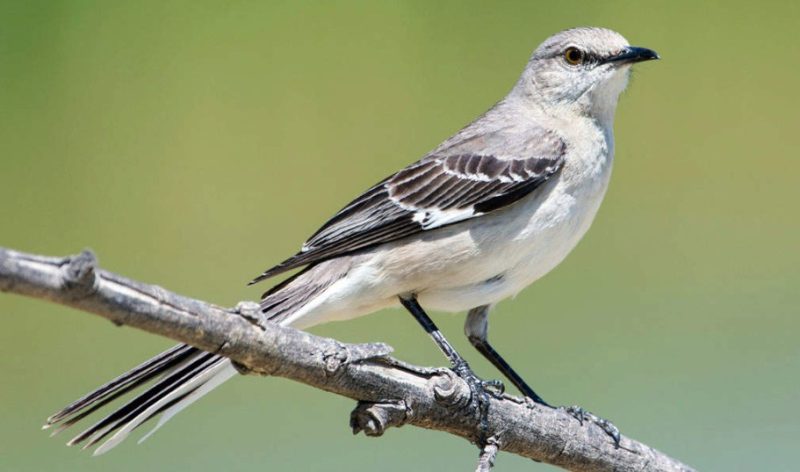
The Northern Mockingbird is a medium-sized, gray bird with a long tail and white wing patches visible in flight. Known for its incredible vocal abilities, it can mimic the calls and songs of other birds, as well as mechanical sounds. Its persistent singing and territorial behavior make it a familiar presence in Tennessee.
They measure about 8 to 10 inches in length, with a wingspan of 12 to 15 inches. Northern Mockingbirds feed on insects, fruits, and berries, foraging on the ground or in low vegetation. Males are highly territorial, often singing throughout the day and even at night to defend their territories.
In Tennessee, Northern Mockingbirds are year-round residents, inhabiting suburban areas, gardens, parks, and open woodlands. Their bold behavior, striking wing markings, and impressive vocal repertoire make them one of the most charismatic and easily recognized birds in the state.
Brown Thrasher

The Brown Thrasher is a medium-sized songbird with a rich rufous-brown back and heavily streaked underparts. Its long tail and curved bill are distinguishing features, while bright yellow eyes add intensity to its alert expression. Known for its large song repertoire, the Brown Thrasher can sing thousands of different phrases, making it one of Tennessee’s most talented vocalists.
They measure about 9 to 12 inches in length, with a wingspan of 11 to 14 inches. Brown Thrashers forage on the ground, sweeping aside leaves with rapid side-to-side movements to uncover insects, berries, and seeds. They are territorial during the breeding season, often singing from elevated perches to defend their area.
In Tennessee, Brown Thrashers are widespread summer residents, inhabiting dense shrubs, thickets, woodland edges, and suburban gardens. Their bold presence, vibrant plumage, and complex songs make them a memorable and characteristic bird of the state’s brushy habitats.
Gray Catbird
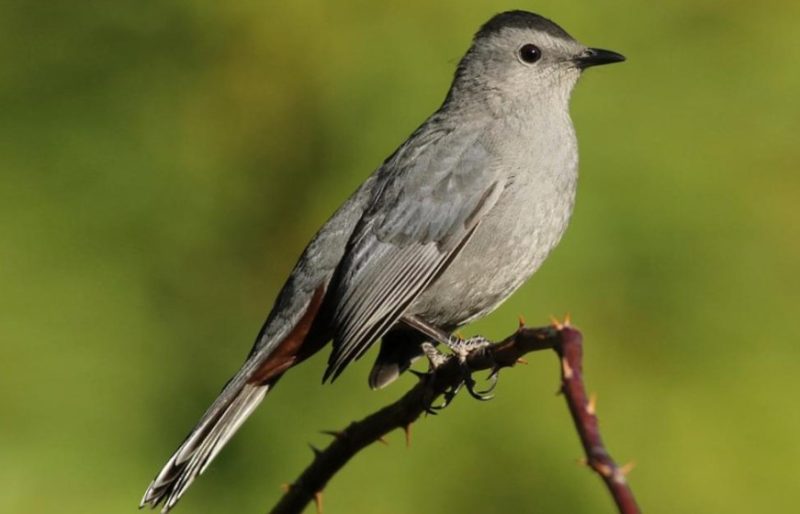
The Gray Catbird is a medium-sized, slate-gray bird with a black cap and rusty undertail patch. Its plain coloration belies its remarkable vocal abilities, including imitations of other birds and sounds. Named for its distinctive “mewing” calls, the Gray Catbird is often heard before it is seen, darting through dense shrubs and thickets.
They measure about 8 to 9 inches in length, with a wingspan of 11 to 13 inches. Gray Catbirds feed on insects, berries, and fruits, often hopping actively through low vegetation while foraging. They are secretive by nature but become more visible during courtship and nesting periods.
Gray Catbirds are common summer residents throughout Tennessee, frequenting forests, woodland edges, overgrown fields, and suburban gardens. Their vocal complexity and subtle plumage make them a favorite for birdwatchers, especially those attentive to their hidden, brushy habitats.
White-breasted Nuthatch

The White-breasted Nuthatch is a small, agile bird easily identified by its white face and underparts, blue-gray back, and black cap. Its habit of climbing headfirst down tree trunks is a signature behavior, helping distinguish it from other small woodland birds. Nuthatches are energetic foragers, probing bark crevices for insects and seeds.
They measure about 5.1 to 5.9 inches in length, with a wingspan of 8.7 to 10.6 inches. White-breasted Nuthatches also feed on nuts and seeds, often wedging them into bark to hammer them open. Their nasal, yank-yank calls are familiar in wooded areas across Tennessee.
White-breasted Nuthatches are year-round residents in Tennessee, inhabiting deciduous and mixed forests, parks, and suburban areas with mature trees. Their acrobatic foraging and distinctive vocalizations make them easily recognizable to both casual observers and dedicated birders.
Red-breasted Nuthatch
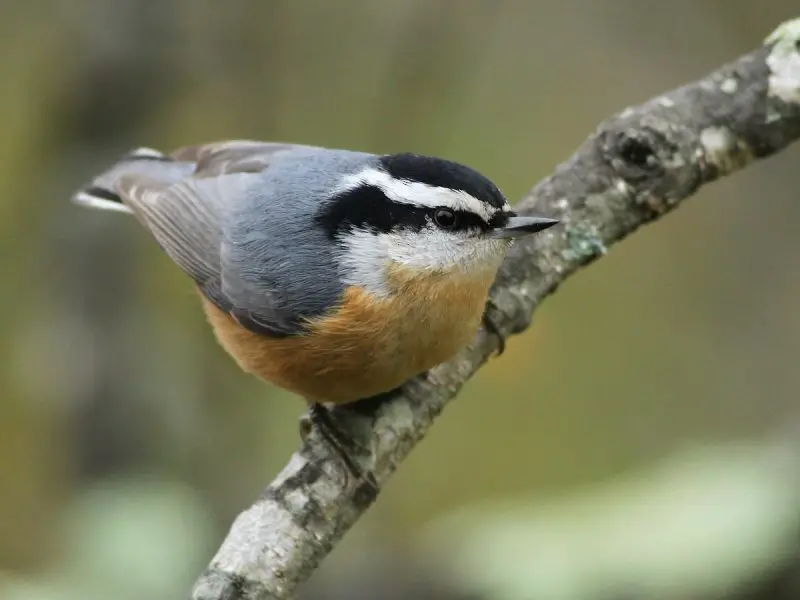
The Red-breasted Nuthatch is slightly smaller than its white-breasted counterpart and is notable for its rusty underparts and blue-gray back. It also has a black stripe through the eye and a white supercilium above. Like other nuthatches, it often moves headfirst down tree trunks and branches while searching for insects and seeds.
They measure about 4 to 4.5 inches in length, with a wingspan of 7.5 to 9.1 inches. Red-breasted Nuthatches feed on insects, seeds, and occasionally suet at feeders. Their high-pitched, nasal “yank-yank” calls are often given in rapid series and are a key identifier.
Red-breasted Nuthatches are primarily winter visitors in Tennessee, arriving from northern forests. They inhabit coniferous and mixed woodlands and are especially attracted to areas with abundant pine and spruce trees. Their small size, rapid movements, and distinctive calls make them an engaging species to spot during colder months.
American Kestrel
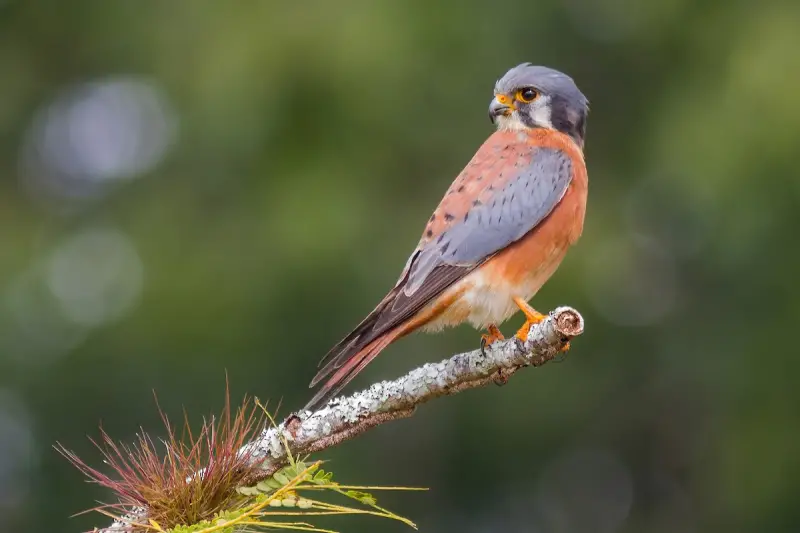
The American Kestrel is the smallest falcon in North America, noted for its striking plumage and agile hunting behavior. Males have slate-blue wings and rufous back and tail with black barring, while females are more uniformly rufous with black streaks. Their sharp, hooked bill and keen eyesight make them formidable small raptors despite their diminutive size.
They measure about 8.7 to 12 inches in length, with a wingspan of 20 to 24 inches. American Kestrels feed on insects, small birds, and rodents, often hunting from elevated perches or while hovering in place. Their sharp, chattering calls announce their presence and territorial defense.
American Kestrels are year-round residents across Tennessee, frequenting open fields, meadows, farmland edges, and suburban areas with scattered trees. Their colorful plumage, dynamic flight, and hunting acumen make them one of the most admired raptors in the state.
FAQs About Common Birds in Tennessee
What is the best time to observe Eastern Meadowlarks in Tennessee?
Eastern Meadowlarks are most easily observed during the spring and summer months when they are singing to defend territories. Open fields, pastures, and prairies provide the best viewing locations.
How can I identify a Ruby-throated Hummingbird?
Males have an iridescent red throat and green back, while females lack the red throat and have lighter underparts. They are extremely small and hover near flowers or feeders to sip nectar.
Where do Barn Swallows build their nests?
Barn Swallows typically build cup-shaped mud nests on man-made structures such as barns, bridges, eaves, and other sheltered ledges. They prefer locations near open fields or water where insects are abundant.
What do Cedar Waxwings eat?
Cedar Waxwings primarily feed on berries and fruits but also eat insects during the breeding season. They are often seen in large flocks, passing berries from one bird to another.
Are Northern Mockingbirds year-round residents in Tennessee?
Yes, Northern Mockingbirds are found year-round in Tennessee. They inhabit suburban areas, parks, gardens, and open woodlands, and are easily recognized by their long tails and vocal mimicry.
How can I distinguish a Carolina Chickadee from a Black-capped Chickadee?
Carolina Chickadees are slightly smaller with a more subtle black-and-white head pattern. Black-capped Chickadees are more common in higher elevations and have a larger size with a more contrasting head pattern.
When do Red-breasted Nuthatches visit Tennessee?
Red-breasted Nuthatches are primarily winter visitors, arriving from northern forests. They favor coniferous and mixed woodlands and are often attracted to feeders with seeds and suet.
What is the diet of the American Kestrel?
American Kestrels feed on insects, small birds, and rodents. They hunt from elevated perches or by hovering mid-air and are often seen in open fields and farmlands.
How do Gray Catbirds behave in their habitat?
Gray Catbirds are secretive, often moving through dense shrubs and thickets. They forage for insects and berries, and their “mewing” calls are distinctive.
Where do Tree Swallows typically nest?
Tree Swallows are cavity nesters, often using abandoned woodpecker holes or nest boxes. They are commonly found near wetlands, ponds, and open fields with suitable nesting sites.

